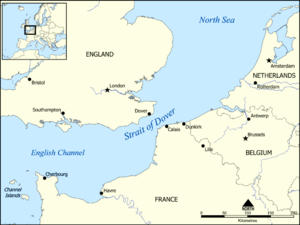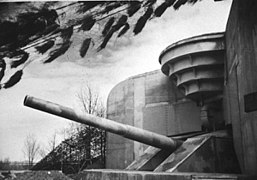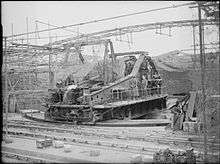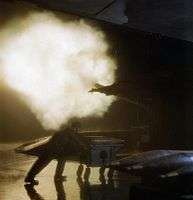Dover Strait coastal guns
The Dover Strait coastal guns were British and German long-range coastal artillery pieces, on the English Channel coasts of Kent, England and the Pas-de-Calais, occupied France. The Strait of Dover is the narrowest channel between England and continental Europe. During the Second World War, both sides used their guns to bombard shipping in the Channel as well as coastal towns and military installations.
| Dover Strait coastal guns | |
|---|---|
| Part of British coast defences/Atlantikwall | |
| English Channel Near Dover/Calais in Britain/occupied France | |
 Strait of Dover | |
| Coordinates | |
| Site information | |
| Operator | Dover Command/Kriegsmarine |
| Controlled by | British Army/German Navy |
| Condition | Museum pieces or demolished |
| Site history | |
| Built | 1940 |
| Built by | British civilian contractors/Organisation Todt |
| In use | 1944 |
| Materials | Steel-reinforced concrete |
| Fate | Defunct |
| Battles/wars | Channel convoys Channel Dash Operation Undergo |
| Events | Battle of Britain Normandy landings |
History
The outcome of the Battle of France in June 1940 placed the Pas-De-Calais under the control of an enemy of Britain for the first time since the end of the Napoleonic Wars. On 21 May 1940, Hitler discussed the possibility of invasion with Großadmiral (Grand Admiral) Erich Raeder, the Commander-in-Chief of the Kriegsmarine (German Navy) and on 25 June surprised Oberkommando der Wehrmacht (OKW, supreme command of the armed forces), by ordering the preparation studies and appreciations for an invasion of Britain, which were ready on 2 July.
In an OKW directive on 10 July, the purpose of the guns was to provide
All preparations are to be made to provide strong frontal and flank artillery protection for the transportation and landing of troops in case of a possible crossing from the coastal strip Calais–Cape Gris Nez–Boulogne.
— Keitel[1]
under the control of the Kriegsmarine.
Hitler issued Fuhrer Directive 16 on 16 July for an invasion as Unternehmen Seelöwe (Operation Sea Lion), in which,
Strong forces of coastal artillery must command and protect the forward coastal area.
— Hitler 16 July 1940[2]
Organisation Todt began work on positions capable of withstanding the heaviest bombing for every heavy artillery piece available, primarily at Pas-de-Calais, commenced on 22 July 1940.[3]
German guns

The first such guns began to be installed around the end of July 1940. First came Siegfried Battery at Audinghen, south of Cap Gris-Nez, with one 38 cm SK C/34 naval gun (15-inch) gun (later increased to 4 and renamed Todt Battery), shortly followed by:
- Three 30.5 cm (12.0 in) guns at Friedrich August Battery, to the north of Boulogne-sur-Mer
- Four 28 cm (11 in) guns at Grosser Kurfürst Battery at Cap Gris-Nez
- Two 21 cm (8.3 in) guns at Prinz Heinrich Battery just outside Calais
- Two 21 cm (8.3 in) guns at Oldenburg Battery in Calais
- Three 40.6 cm SK C/34 (16-inch) guns (from among the so-called Adolf Guns) at Lindemann Battery between Calais and Cap Blanc-Nez. The battery was named Lindemann after the fallen captain of the battleship Bismarck.
By early August, Siegfried Battery and Grosser Kurfürst Battery were fully operational as were all of the Army’s railway guns. Seven of the railway guns, six 28 cm (11 in) K5 guns and a single 21 cm (8.3 in) K12 gun with a range of 115 km (71 mi), could only be used against land targets. The remainder, thirteen 28 cm (11 in) guns and five 24 cm (9.4 in) guns, plus additional motorised batteries comprising twelve 24 cm (9.4 in) guns and ten 21 cm (8.3 in) guns, could be fired at shipping but were of limited effectiveness due to their slow traverse speed, long loading time and ammunition types. Land-based guns have always been feared by navies because they are on a stationary platform and are thus more accurate (and can be larger, with more ammunition stowage) than those on board ship. Super-heavy railway guns can only be traversed by moving the entire gun and its carriage along a curved track, or by building a special cross track or turntable. This, combined with their slow rate of fire (measured in rounds per hour or even rounds per day), makes it difficult for them to hit moving targets. Another problem with super-heavy guns is that their barrels (which are difficult to make and expensive to replace) wear out relatively quickly, so they could not be fired often.
Better suited for use against naval targets were the four heavy naval batteries installed by mid-September: Friedrich August, Prinz Heinrich, Oldenburg and Siegfried (later renamed Todt) – a total of eleven guns, with the firepower of a battlecruiser. Fire control for these guns was provided by both spotter aircraft and by DeTeGerät radar sets installed at Blanc-Nez and Cap d’Alprech. These units were capable of detecting targets out to a range of 40 km (25 mi), including small British patrol craft near the English coast. Two additional radar sites were added by mid-September: a DeTeGerät at Cap de la Hague and a FernDeTeGerät long-range radar at Cap d’Antifer near Le Havre.[4]
Perhaps the most remarkable gun was the 21 cm (8.3 in) Kanone 12 in Eisenbahnlafette, manned by the German Army. The gun had an effective range of 45 km (28 mi). Designed as a successor to the World War I Paris gun, it is claimed to have had a maximum range of 115 km (71 mi). Shell fragments from the gun were found near Chatham, Kent, 88 km (55 mi) from the nearest point on the French coast. There were two of these guns, operated by Artillerie-Batterie 701 (E) and they remained on the Channel Coast for the rest of the war.
The guns started shelling the Dover area during the second week of August 1940 and continued firing until September 1944. Over a thousand rounds were fired but the German coast batteries only sank:
Empire Lough was one of 21 coastal vessels in the convoy ETC-17, escorted by the frigate HMS Dakins and corvette HMS Sunflower. On 24 June 1944, the convoy left Southend en route to the Seine Bay when the ships were engaged by German long-range coastal artillery guns off Dover. Empire Lough was set on fire and declared a total loss after she was beached near Folkestone. The master Robert Robinson and one crew member were lost. The freighter Gurden Gates (1,791 grt, built 1943) was damaged in the same action.
British guns

Having withdrawn in the Dunkirk evacuation and winning the Battle of Britain, the British did not have an immediate answer to this threat but the high ground to either side of the Port of Dover was fortified on the personal order of Prime Minister Winston Churchill (who had visited to see the situation in person) and large calibre guns dug in there. The only British cross-Channel guns already in place were Winnie (named after Churchill) and – later in 1940 – Pooh (named after the story book character Winnie the Pooh who in turn was named after "Winnipeg" the bear at the London Zoo).[7] These were two BL 14 inch Mk VII (35.6 cm) guns positioned behind St Margaret's. They were spares taken from the stock of guns of the battleship HMS King George V. One used a mounting from HMS Furious and the other a mounting from a test range; neither was turret-mounted. They were operated from a separate firing-control room and were manned by 25 men of the Royal Marine Siege Regiment. These boosted morale – Winnie fired Britain's first shell onto continental Europe in August 1940 – but were slow and ineffectual compared to the German guns. They conducted extreme range counter-battery operations against the German guns (though they were too inaccurate and slow to fire on ships) and were protected from German aerial attack by anti-aircraft emplacements. Their separate and well-camouflaged cordite and shell magazines were buried under deep layers of earth and connected to the guns by railway lines.
Due to these guns' lack of success in targeting shipping, Churchill ordered three new heavy gun batteries to be built in Dover and manned by the Royal Artillery for that purpose:
- Three BL 6-inch (152 mm) Mk VII guns with a range of 25,000 yd (23,000 m), at Fan Bay Battery
- Four BL 9.2-inch (234 mm) Mks IX–X guns with a range of 31,000 yd (28,000 m) at South Foreland Battery
- Two BL 15-inch (381 mm) Mk I guns with a range of 42,000 yd (38,000 m) at Wanstone Battery, known as Clem (after Clementine Churchill) and Jane (after the pin-up).

The guns were later joined by Lydden Spout Battery, consisting of three more BL 6-inch Mk VII guns. Also, three BL 13.5-inch (343 mm) Mk V naval guns from the First World War (named Gladiator, Scene Shifter and Piece Maker [sic]) were brought out of retirement in 1939 and mounted on railway chassis.[8]
The British coast batteries sank:
- Pentiver, 2,382 BRT, 2 March 1943
- Livadia 3,094 BRT, 4 October 1943
- Munsterland 6,315 BRT, 20 January 1944
- Recum 5,500 BRT, 20 March 1944
- S.184 (sunk 5 September 1944, by its own troops)[6]
Hellfire Corner

This gunnery duel, along with heavy German shelling and bombing of Dover strait and the Dover area, led to this stretch of the Channel being nicknamed Hellfire Corner and led to 3,059 alerts, 216 civilian deaths and damage to 10,056 premises in the Dover area. British coastal convoys had to pass through the bottleneck of the Dover strait to transport supplies, particularly coal; Britain's road and rail network was not then able to cope with the volume of traffic that had to be handled. Although the German guns regularly fired on these slow moving convoys from 1940 to 1944, with an interlude in 1943, they only sank two ships and damaged several others. Two seamen were killed and others were injured by shell splinters from near misses. However, the civilian crews of the merchant ships found the shelling more unnerving than the attacks by aircraft or E-boats that they were also subjected to and there were instances of crews refusing to sail from their forming-up point at Southend-on-Sea because of the German guns.[9]
The Channel Dash
On 11 February 1942, the German battleships Scharnhorst and Gneisenau, the heavy cruiser Prinz Eugen and more than twenty smaller escort vessels sailed from Brest in Brittany to their home port of Wilhelmshaven by an audacious dash through the English Channel, codenamed Unternehmen Zerberus (Operation Cerberus). Due to poor visibility and a number of communication failures by British forces, the first response to the German squadron was by the 9.2-inch guns of the South Foreland Battery, which were the only guns which could be directed by radar but the 10-cm K band set had only recently been installed and had never been used in conjunction with the guns. As the visibility was only 5 nmi (5.8 mi; 9.3 km), it was hoped that the radar would be able to register the splashes as the shells landed so that the guns would be able to correct their aim but nothing was detected. After firing three two-gun salvoes without being able to detect the "fall of shot" – the shells were actually landing almost a mile astern of the main German ships – it was decided to fire full salvoes using only the ranging information from the radar. After six minutes of rapid fire, the last shots were fired at a range of 30,000 yd (27,000 m). None of the 33 shells fired came close to the German ships. A minute before the last shots were fired, South Foreland came under counter-battery fire from across the Channel but little damage was sustained.[10]
Final duels
During the Anglo-Canadian operation to capture Calais, on 26 September 1944 (the last day of shelling) fifty shells were fired, killing five people, the last of whom was 63-year-old Patience Ransley, who was killed by a shell from the Lindemann Battery while sheltering in the 900 ft (270 m) long "Barwick's Cave" reinforced cliff tunnel.[11] Accurate bombardment from the British heavy guns at Dover disabled the Grosser Kurfürst Battery at Floringzelle near Cap Gris Nez, ending the duels.[12] Dover was finally freed from bombardment and to mark the event the town's mayor was sent a German flag from the batteries.[13]
Aftermath
Between Calais and Boulogne-sur-Mer considerable parts of the concrete gun emplacements and associated bunkers remain accessible, although often in somewhat dangerous conditions. One of the casemates of the Todt Battery can be visited at the Musée du Mur de l'Atlantique, the Atlantic Wall Museum, at Audinghen.[14] One of the Krupp K5 guns is also there. Since 1954, a section of painted armour plating taken as a war trophy from a turret of the Lindemann Battery has been on display on the Dover seafront. Many of the British batteries remained until the decision was taken to retire all the coastal artillery in 1956. The big 15-inch guns at Wanstone Farm were not removed until 1959.[15] The sites have either been demolished, buried or left to decay. At Wanstone Farm Battery, ancillary buildings such as the plotting room and the guard house are visible, although overgrown and the sergeants' mess has reverted to its original use as a farm house.[16]
Gallery
 A gunner of 428 Battery, Coast Defence Artillery, pushing a gun trolley loaded with shells, as guns fire at night, December 1942
A gunner of 428 Battery, Coast Defence Artillery, pushing a gun trolley loaded with shells, as guns fire at night, December 1942 Sangatte Battery near Calais, used for cross-channel bombardment
Sangatte Battery near Calais, used for cross-channel bombardment The derelict Battery Observation Post at Hougham Battery which was constructed in 1941 for three 8 inch Mk VIII naval guns
The derelict Battery Observation Post at Hougham Battery which was constructed in 1941 for three 8 inch Mk VIII naval guns
See also
- V-3 cannon German supergun of 1943–44 at Mimoyecques, Pas-de-Calais
- Dover Castle
- Hougham Battery
- List of naval guns
- Operation Sea Lion
- Fan Bay Deep Shelter
Footnotes
- CARL 2008, pp. 106–107.
- CARL 2008, p. 108.
- CARL 2008, p. 109.
- Schenk 1990, pp. 324–325.
- "WRECKSITE - SAMBUT CARGO SHIP 1943-1944". www.wrecksite.eu. Retrieved 13 September 2019.
- Sakkers & Machielse 2013.
- Evans 2004, p. 59.
- Clarke 2005, pp. 41–42.
- Hewitt 2008, p. 109.
- Ford 2012, pp. 33–36.
- Vaughan 2009.
- Copp 2006, p. 82.
- Stacey 1960, pp. 344–354.
- "Musée du Mur de l'Atlantique - Batterie Todt". Musée du Mur de l'Atlantique. Retrieved 13 September 2019.
- Gander 2011.
- Catford 2011.
References
- Catford, N. (2011). "Hougham Battery - Fortress & Battery Plotting Room". Subterranea Britannica. Retrieved 20 October 2016.
- Copp, Terry (2006). Cinderella army: the Canadians in north-west Europe, 1944–1945. University of Toronto Press. ISBN 0-8020-3925-1.CS1 maint: ref=harv (link)
- Clarke, Dale (2005). British Artillery 1914–19: Heavy Artillery. London: Osprey.
- Evans, Martin Marix (2004). Invasion! Operation Sealion 1940. London: Longmans. ISBN 978-0-582-77294-6.CS1 maint: ref=harv (link)
- Ford, Ken (2012). Run The Gauntlet: The Channel Dash 1942. London: Osprey. ISBN 978-1-84908-570-0.CS1 maint: ref=harv (link)
- Gibbs, Jay; Grobmeier, A. H. & Zolandez, Thomas (2006). "Question 11/05: Cross Channel Guns". XLIII (2): 133–142. ISSN 0043-0374. Cite journal requires
|journal=(help) - Fuhrer Directives and other Top-Level Directives of the German Armed Forces, 1939–1941. World War II Operational Documents. Part 2 (Combined Arms Research Library Digital Library ed.). Washington, DC: U.S. Office of Naval Intelligence. 2008 [1948]. OCLC 464601776. N16267-A. Retrieved 20 October 2016.CS1 maint: others (link)
- Gander, Terry (2011). "Twentieth Century British Coast Defence Guns" (PDF). www.fsgfort.com. Fortress Study Group. Archived from the original (PDF) on 14 April 2014. Retrieved 13 April 2014.CS1 maint: ref=harv (link)
- Hewitt, Nick (2008). Coastal Convoys 1939–1945: The Indestructible Highway. Pen & Sword Maritime. ISBN 978-1-84415-861-4.CS1 maint: ref=harv (link)
- Sakkers, Hans; Machielse, M. (2013). Artillerieduell der Fernkampfgeschütze am Pas de Calais 1940–1944: aus Sicht der schweren deutschen Marinebatterien "Großer Kurfürst", "Todt", "Prinz Heinrich", "Friedrich August", "Lindemann" und der Heeres-Eisenbahnartillerie [Artillery Duel of the Long-Range Guns in the Pas de Calais 1940–1944: from the Perspective of the Heavy German Naval Batteries "Großer Kurfürst", "Todt", "Prinz Heinrich", "Friedrich August", "Lindemann" and the Army Railway Guns] (in German). Aachen: Helios. ISBN 978-3-86933-092-1.
- Schenk, Peter (1990). Invasion of England 1940: The Planning of Operation Sealion. London: Conway Maritime Press. ISBN 978-0-85177-548-7.
- Stacey, Colonel Charles Perry; Bond, Major C. C. J. (1960). "XIV; Clearing the Coastal Belt and the Ports, September 1944". The Victory Campaign: The Operations in North-West Europe 1944–1945 (PDF). Official History of the Canadian Army in the Second World War. III (online ed.). The Queen's Printer and Controller of Stationery Ottawa. pp. 336–344. OCLC 256471407. Retrieved 11 October 2016.
- Vaughan, J. (2009). "The Unlikely Death of Patience Ransley". The Dover War Memorial Project. Retrieved 20 October 2016.
Further reading
- Monaghan, J. W. (24 September 1947). "Part V: Clearing the Channel Ports, 3 Sep 44 – 6 Feb 45". Operation "Wellhit", – The Capture of Boulogne (pdf). Canadian Participation in the Operations in North-West Europe 1944 (Report). Historical Section, Canadian Military Headquarters. pp. 11–37. Report 184. Retrieved 20 October 2016.
External links
- Batterie Todt in Northern France
- DoverPages
- BBC People's War
- Cross channel bombardments during Second World War
- British Pathé wartime newsreel of the 14-inch gun "Winnie" being loaded and fired
- British Pathé wartime newsreel of ships being shelled - the shells miss and a spotter plane turns up but is forced to retreat by the RAF
- Terry Gander, Twentieth century British coast defence guns